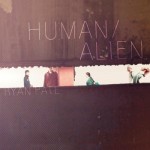 HUMAN/ ALIEN
HUMAN/ ALIEN
Ryan Pate- gtr, Dov Manski- pno, Noah Garabedian- bs, Devin Gray- dm
71’30” 8 tracks, all original
Into the eight original tracks of Human/ Alien, leader Ryan Pate packs over seventy minutes of creative thought, a statement unto itself. In his debut as a leader, the quickly- emerging Brooklyn guitarist proves his skills as both a composer and player, bringing a fresh approach to each.
Compositional input beyond that of typical small group outings is immediately evident in the involved bass and piano counter-lines under the melody of the opening Simple Song #3, as well as in its unfolding through-composed form and further polyphony. Pate’s skills as a guitarist also shine right from this track, first soloing convincingly over drummer Devin Gray’s thrashing groove, and later blending tastefully in a more subdued collective improvisation with pianist Dov Manski.
The contrast implied in the album title surfaces often in tension between warm, longing melodies against more abrasive harmonies and unsettling textures. Where this comes out in the segmented form of the title track, it’s best captured in what could be a Stephen King-inspired dream scape (or nightmare scape) called Growth Cycles. Here an especially earthy and organic guitar melody rests over a cascade of expressionistic piano arpeggios. Frequent minor ninths reinforce the colder side of the equation, and Pate wastes no time setting the chilly tone with the opening three chords separated by deep, dark space.
To See One Through captures the album concept perhaps even more, where the contrast equation flips over. After a funky drum intro, six strings become tentacles that slither down the walls to disturbing effect, later returning in more subtle ways. But at two key moments a reassuring chorale progression of earth tones emerges, blossoming beneath an upper pedal. Now human scenery overtakes an alien foreground.
Extraterrestrials prevail, however, in Circulation Adjustment Machine, as all four band members now probe an atmosphere of blips, clicks and pings. From here, motivic amoeba gradually bud into human-discernable life forms, eventually crystallizing into a full organism as the ensemble coalesces into tempo and tutti. However, the parasitic sound swarm that opened the piece never fully recedes, and in fact reveals itself through the host’s skin at times, suggesting a careful self-examination in all of us.
The title track encapsulates much of the composer’s traits found in the album: long, slow-developing forms, occasional quirky passages, subtle color shifts, and multiple episodes that reinforce the piece’s through-composed nature. Here a bass habañera establishes time, shifting colors between ominous and comforting. About midway through the piece, a feeling of human resilience emerges via a lingering three-chord vamp over which Pate and Manski pour convincing, energetic figures.
It’s worth speaking about Pate’s potent palette for a moment. Peppered through the album are his hidden experiments in tambre, from the shimmering piano in the slow unison melody of Pen and Sword, to sitar-like meditative background strumming in To See One Through, to mining a single sonority with staggered brush strokes in E.S., to name a few (and there are many more). The variety of sound heard is significant considering what Pate is able to extract from four instruments. Harmonically, one notices a trait towards chord qualities shifting under a common tone, another example of the leader’s ability to draw more out of less.
Overall one gets a sense of what may be Pate’s style, as both a guitarist and composer: a masterful use of color, a playful quirkiness amid otherwise dark backdrops, and a heartfelt honesty captured in melodies and improvisations that speak fluidly to the listener. But perhaps the greatest offering from Human/Alien is the leader’s unique imagination and his ability to clearly project it. In a field where this isn’t always the case, this deserves a closer and wider look.
Listen to Human/ Alien at http://ryanpate.bandcamp.com/
Jeff Fairbanks